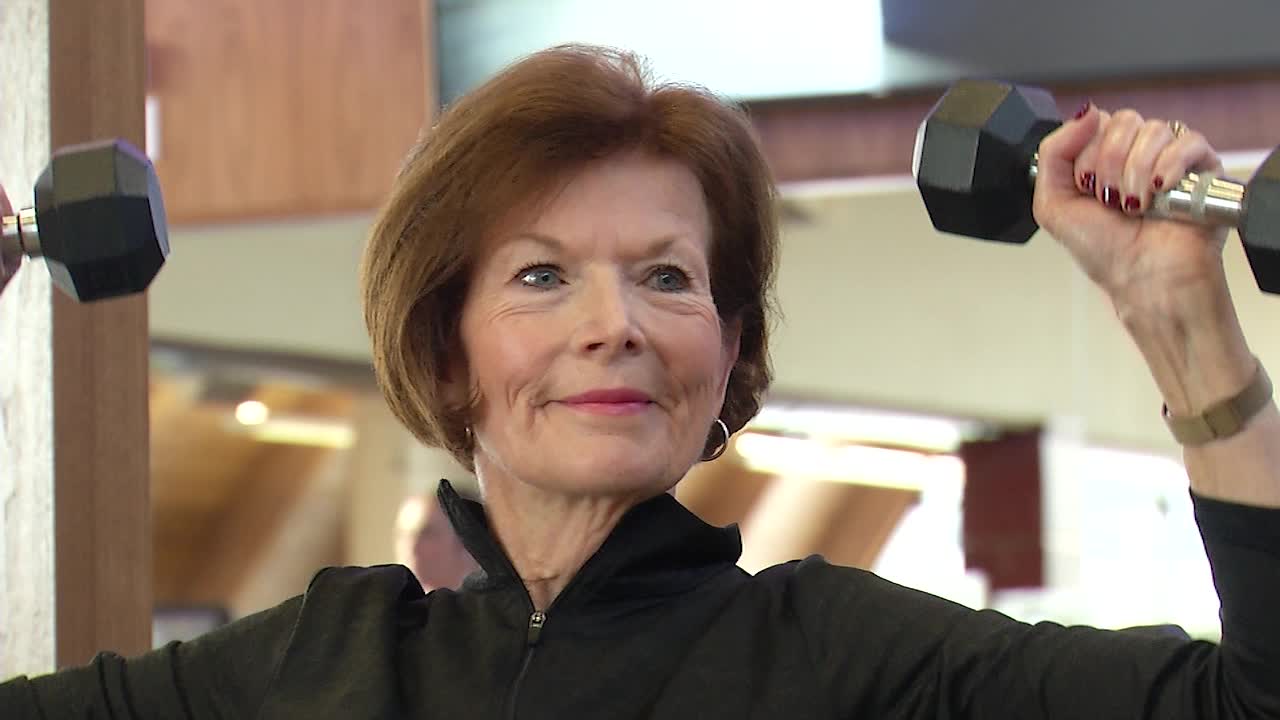For seniors, strength training is a key element to longevity, quality of life
Harriet Witt is serious about fitness.
“I am not a wimp. I am not a wimp,” she smiles. “Everybody is coming to the gym. Fifty, 60, 70 — it doesn’t matter what age you are to work out. You should feel good about it.”
Witt, 68, from Wayzata, and her gym buddy, Ruth Ann Swanson, 71, from Chaska, are passionate about strength training as a part of their fitness regimen.
“You don’t have mobility if you don’t have the strength to do things, so it’s so tied together,” declares Swanson. “If you’re talking about groceries, for example, if you’re talking about even lowering yourself into a chair and getting up, what are you using? All these muscles. If you let them go, they’re not going to work for you.”
Liz Berg, an instructor at Life Time in Eden Prairie, has coached people in the fitness business for 37 years.

Ruth Ann Swanson, 71, lifts dumbbells during a training session Thursday, March 2, 2023, at Life Time in Eden Prairie. (KSTP)
She says the approach for physical training — for seniors and everyone else — has evolved over the years.
“We realized if you combined that cardio activity and strength training together, possibly both, your one hour becomes really, really efficient,” Berg said.
Witt says being coached by Berg and getting into the gym on a regular basis has made a huge difference in her life.
She says she was in a serious car accident four years ago that left her with a spinal cord injury and paralysis in one-quarter of her body.
“So strength training became very critical at that time because I was never going to walk again or use my hands again,” Witt recalls.
She still has trouble doing certain moves like skipping but says she’s been working out for 20 years and has felt the benefits.
“It challenges the muscles and it ignites everything in the nervous system,” Witt says. “If you’re not igniting your spinal cord and your nervous system, that’s just movement. You need that strength to get that thrust.”
Experts say one reason for all the interest in fitness for seniors is that the world population is aging: The number of people aged 65 and older is projected to grow to 1.5 billion by 2050.
“It comes down to quality of life,” explains Beth Lewis, a professor at the University of Minnesota’s School of Kinesiology. “So we have people living longer, what is that quality of life like?”
Lewis and her colleagues specialize in the scientific study of the human body’s movement.
She says researchers are changing their viewpoint on fitness for seniors.
“We’ve done a little bit of a disservice by just saying, ‘OK, just go out and walk, you’ll be fine, that’s enough,’” Lewis said. “[We’ve said], ‘Sorry, you should do that, it’s really important for cardiovascular disease prevention. But you also should to do strength training in order to prevent muscle loss over time.'”
An Annual Review of Medicine study published in 2022 found “even frail individuals or those aged 85 years can achieve measurable improvements in muscular strength and power several weeks to months of resistance training.”
The report found even a single weekly resistance exercise session produced beneficial changes in muscular strength in older adults.
“I think they’re finding out that people that don’t strength train and they’re older and they feel they can’t come back from that fall easily or at all,” Berg said.
Experts say building muscle strength — the ability to exert force — allows us to do simple tasks like climbing stairs or lifting groceries out of the car.
One reason why researchers are focusing on this, is that muscle mass decreases by up to 8% each decade after 30. That process, they say, accelerates after 60.
Berg says walking for seniors is a great start, but building muscle mass, she says, helps with strength and a lot more.
“Walking is great. I don’t want to dissuade anyone from getting out and walking and moving. Moving is a big thing,” she explains.
But strength training, Berg says, will help you stay fit into your advanced years.
“Your movements become more fluid. You’re more apt to be able to balance when you’re about to fall,” she says. “It helps with balance. It helps with movement. It helps with getting up. Just getting up.”
Berg says seniors just starting to work out don’t necessarily need weights at home. Even simple exercises like using soup cans or a bag of books can be used for bicep curls, for example.
For her part, Swanson says getting into the gym helps with other activities, like sports or travel.
“Mine is like retirement training,” she says. “You know, if you want to travel, you have to be able to get around, carry your suitcase or whatever. The working out is like a gift to yourself.”
You can find out more about Berg’s training tips here.